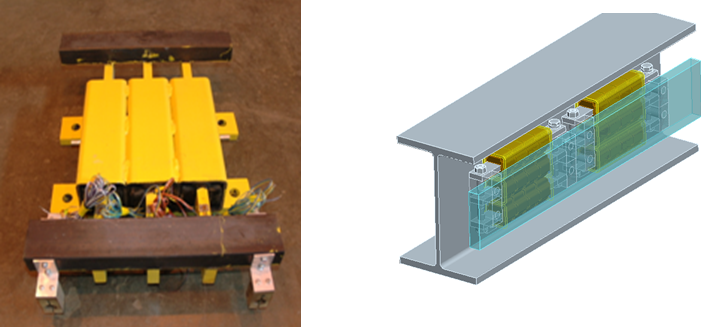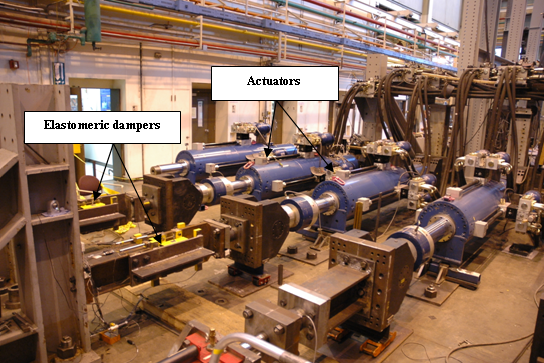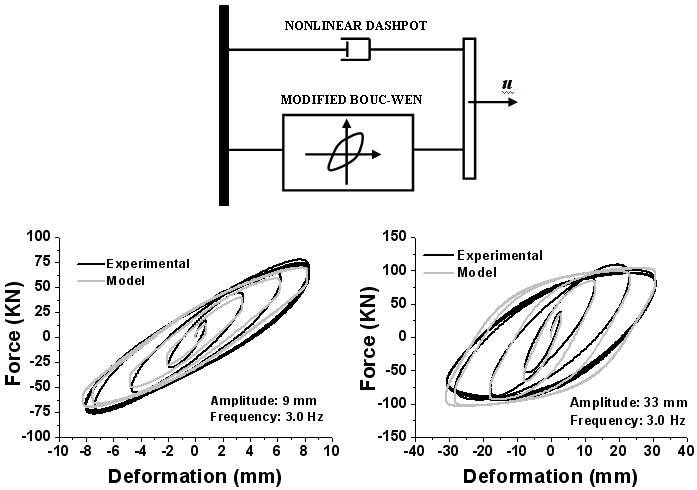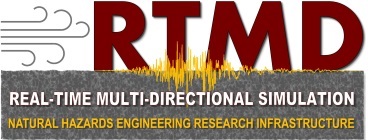Performance-Based Design Of Buildings For Earthquake Conditions Using Next-Generation Elastomeric Dampers
Project Summary
Structural vibrations caused by wind or earthquake can lead to damage of the structure. As a result, the structure will have to be repaired or possibility demolished. Recently there have been a number of new devices developed that enables structural systems to withstand wind or earthquake induced vibrations with minimal damage. Examples of these devices include passive dampers and semi-active dampers.
The study will investigate the use of elastomeric dampers for reducing the vibrations from wind and earthquakes on structures. Real-time hybrid testing techniques will be utilzed to perform a series of experiments involving simlated wind and seismic loading on a building structure. The dampers will be modeled in the laboratory, using an existing large-scale damper test setup. The remaining part of the structure will be modeled analytically in order to include the effects of interaction of the dampers and the structure under various arrangements of the dampers in the structure. The data collected from the experiments are to be utilized to assess performance, develop analytical models of the damper, and to assist in the establishment of a performance-based design methodology.
Project Description
The project builds upon results from prior studies on elastomeric dampers, where a first-generation damper was constructed and mechanical properties for the damper were obtained. These studies helped to establish real-time hybrid simulation methods for structural systems with passive dampers, which led to preliminary assessment of these dampers for vibration control under seismic loading.
Based on the results from these prior studies, a first generation elastomeric damper developed by Corry Rubber Corporation was evaluted for use in reducing structural damage to buldings during the design earthquake. Tests were performed on the damper to establish their mechanical properties. Preliminary designs of a prototype structure using the passive dampers revealed that a large number of dampers were required in order to meet performance-based design objectives under the design earthquake. Tests on structures under earthquake loading conditions performed using real-time hybrid simulation methods confirmed the need for improvement in the damper design. In addition, the tests performed to establish the mechanical properties of the damper and in the hybrid simulations revealed that the damper exhibits slip and dissipate energy due to friction at moderate amplitudes of deformation. It was concluded that new analytical models have to be developed in order to accurately protray the hysteretic behavior of the damper, which is both rate-dependent due to its elastomeric composition and deformation amplitude due to slip.
The study will involve developing with Corry Rubber Corporation the next generation of elastomeric dampers. These dampers will result in a more efficient design, where fewer dampers are required to achieve design objectives for a structure. The tasks for the proposed project include: (1) providing input to Corry Rubber Corporation for constructing the next-generation of large-scale elastomeric dampers; (2) performing tests on the damper to establish the mechanical properties for a range of frequencies and deformation amplitudes; (3) revise the performance-based design procedure developed in prior research to incorporate any necessary changes based on the properties and characteristics of the new damper; (4) designing a low-rise prototype building with the dampers that enables selected performance objectives to be economically achieved in the structure during the design earthquake; (5) performing real-time hybrid simulation of the prototype building under a range of seismic hazards to validate the performance of the damper and the performance-based design procedure; (6) use the results from the mechanical property tests and hybrid simulations to calibrate and refine a newly developed analytical model for elastomeric dampers that can be utilized in time history analysis; (7) performing nonlinear time history analyses of the prototype building with dampers to investigate effects of parameters varied in the design (e.g, performance level, design criteria) and to further validate the performance-based design procedure.
The Real-time Multi-directional (RTMD) Earthquake Simulation Testing Facility has recently been commissioned at the ATLSS Center. This facility has state-of-the-art servo-hydraulic equipment (servo-valves, accumulation and piping systems). Advanced testing methods have been implemented, enabling the real-time testing of structural components and systems. In the proposed project the dampers can be tested in real-time under realistic loading conditions using the real-time hybrid test method. This test method enables the interaction of the dampers with the structural system to be included in the test, by creating analytical substructures of the remaining parts of the structural system that are coupled to the dampers.
Conclusions
An experimental program based on the use of real-time hybrid simulation to verify the performance-based seismic design of a steel perimeter MRF equipped with compressed elastomer dampers was presented. The experimental substructures for the simulation consisted of two individual compressed elastomer dampers, with the remainder of the MRF and associated tributary gravity columns and gravity loading of the building modeled as an analytical substructure. Real-time hybrid simulation allowed an ensemble of ground motions to be applied to the structure resulting in various levels of damage, without the need to repair the test specimens, since the damage was within the analytical substructure.
Statistical experimental response results incorporating the ground motion variability showed that a steel MRF with compressed elastomer dampers can be designed to perform better than conventional steel SMRFs under the DBE and MCE, even when the MRF with dampers is significantly lighter in weight than the conventional SMRF. In particular, the steel MRF with dampers was designed with a practical number of dampers (eight dampers in the first story and five dampers in the second story) and with a 30% lower steel weight than that of the conventional steel MRF. Real-time hybrid simulations showed that the MRF with dampers experiences significantly lower peak story drifts, peak plastic hinge rotations, lower peak absolute floor velocities and floor accelerations in addition to floor spectra accelerations than those of the conventional steel SMRF.

 Fabrication of compressed elastomer damper: (a) elastomeric material wrapped around longitudinal bar; (b) elastomeric material and bar compressed into the steel tube; (c) damper bottom view with additional bolted transverse bars in place and (d) installation to beam web
Fabrication of compressed elastomer damper: (a) elastomeric material wrapped around longitudinal bar; (b) elastomeric material and bar compressed into the steel tube; (c) damper bottom view with additional bolted transverse bars in place and (d) installation to beam web

Compressed elastomer dampers in test setup

Comparison of experimental hysteresis and hysteretic model
Participants
Faculty
- James M. Ricles – Lehigh University
- Richard Sause – Lehigh University
Post-Doctoral Research Associate
- Cheng Chen – Lehigh University
- Theodore L. Karavasilis – Lehigh University
Academic collaborators
- Robert Michael – Penn State Erie
- Shannon Sweeney – Penn State Erie
Industry
- Ernie Ferro – Corry Rubber Company


